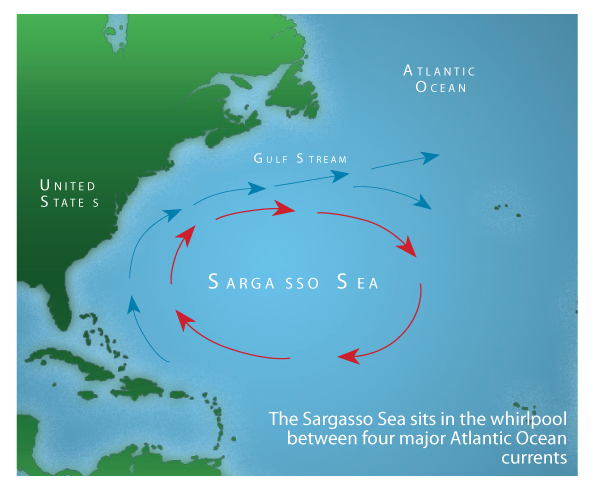Sargasso Sea
THE SARGASSO SEA is located in the North ATLANTIC OCEAN. The area of the sea is found between 20 degrees N and 35 degrees N latitude and 30 degrees W and 75 degrees W longitude—the hump extending northward of BERMUDA. This is also known as the “horse latitudes.” The Sargasso Sea, relatively calm and motionless, is unique, as it has no boundaries or coastline. It is completely surrounded by waters of much faster ocean currents: the anti-cyclonic current system formed by the GULF STREAM, the Canaries current, and the equatorial current. On the west the boundary follows the coast of North America as far as 40 degrees N. The sea depth varies from 5,000 ft to 23,000 ft (1,500 to 7,000 m). It is a vast 2 million square mi (5.2 million square km) ellipse or ovalshaped mass of deep blue waters and spins in a clockwise direction. Sargasso Sea drifts and the changing ocean currents determine its location. The boundary shifts mainly from the force of the gulf stream. There is no similar phenomenon in other oceans.

Clear warm waters and large quantities of floating Sargasso or gulf weeds characterize the sea. The Portuguese word sargasso means “seaweed.” Sargassum is a brown algae with slender stalks, leaflike branches, and a glass bladder, which helps in supporting the stalks by serving as a float. It is normally attached to fixed objects on the bottom but often breaks loose and drifts into the Sargasso Sea. The algae that riddles its surface is actually a deceptive lush veneer to a stretch of ocean that is relatively devoid of life at deeper levels. The gulf weed is a floating plant without any roots. It is a type of LITTORAL flora that is isolated from the coast and has adapted itself in the new environment. The winding bands of water with floating weeds look like plankton rivers. The weeds occur in scattered masses of 100 ft (30.5 m) in diameter. The central part of the ocean possesses thickest weeds. It is estimated that the weed is spread over 2 million square mi (5.2 million square km). Perhaps the weed beds of the West Indies are the ultimate source of these weeds.
Because of its stillness and seaweeds on the surface, the Sargasso Sea is a fascinating ECOSYSTEM. Marine biologists have called it a biological desert, largely devoid of plankton, a basic food supply for fish. It lacks the nutrients necessary to support large fishes. Even in the ocean desert, though, there is an intricate web of life that has adapted to existence among the weeds. The sea is abundant in smaller marine animals such as shrimps, small crabs, and octopi. Much of this marine life is directly dependent on the floating seaweed. Sargassum, a common frogfish, lives amid floating masses of sargassum seaweeds. These fish have developed an art of camouflage to the point where the fish is practically indistinguishable from surrounding seaweeds. The saline waters of the Sargasso are the breeding grounds of eels. Eels from thousands of miles away in North America and Europe swim here to mate and lay eggs. After the eel larva hatch, they make the long swim back. Sea birds are absent in this area, as their prey finds suitable hiding places among the weeds. The atmospheric temperature in this part of the Atlantic is higher—about 78 degrees F (26 degrees C), which helps in the process of evaporation. The higher salinity of Sargasso Sea is attributed to high temperature and greater evaporation and lack of mixture of fresh water by rivers or ice water.
Christopher Columbus, who crossed it on his initial voyage in 1492, first mentioned the Sargasso Sea that encompasses the Bermuda islands. Because the sea is very calm with little wind, sailors since the time of Columbus mistakenly thought that seaweed itself is what trapped their ship. The mysteries of abandoned floating ships are associated with Sargasso Sea. There is no foundation to the belief that the amount and thickness of the weed can hinder a ship. The famed and feared Bermuda Triangle lies within the Sargasso Sea. The mystery of the Sargasso Sea was merely transposed later through the Bermuda Triangle.